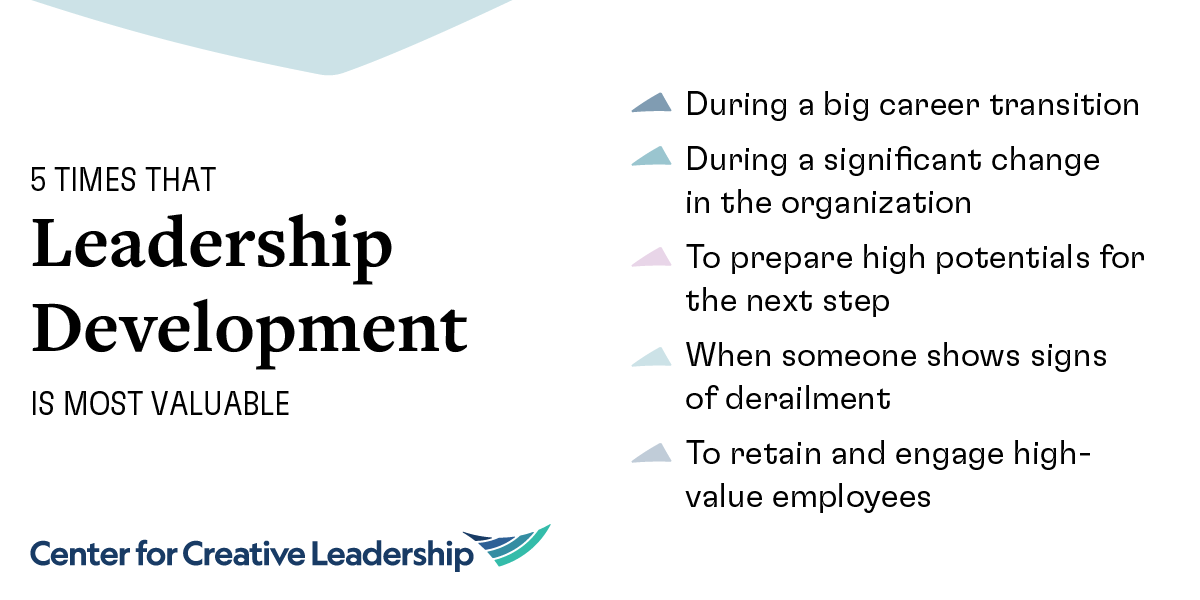When Is Leadership Development Most Valuable?
Developing people is part of what leaders do, but there are often many other demands and priorities, plus limited resources and time. You need a plan for knowing the best times for leadership development to create the best outcomes for your people and your organization.
We’ve worked with experienced talent from all over the world and across industry sectors to learn what it takes to lead change, create strategic alignment, influence others, communicate effectively, and manage up and across the organization.
Here, we highlight the situations when leadership development programs are most worth the investment — to expand the potential of your employees by helping them develop the mindsets, capacity, and capabilities needed to succeed now and to prepare for tomorrow’s challenges.
The Best Times for Leadership Development
Leadership development is wrapped in different packages. More leadership content is available than ever before to anyone, in any role, in all pockets of the organization.
But when does it make sense to invest in something more focused and transformative? When can a leadership program create the most impact to fulfill someone’s leadership potential to positively impact their teams, their organizations, and the world? And how can an open-enrollment experience provide the right impact at the right time?
Here are the 5 times that leadership development is most valuable:
- During a big career transition
- During a significant change in the organization
- To prepare high potentials for the next step
- When someone shows signs of derailment
- To retain and engage high-value employees
1. During a Big Career Transition
The first few months to a year in a new role are loaded with opportunities to gain experience. They can be exciting, challenging, overwhelming — or likely, all 3 at once.
A significant career transition is a time to assess current skills and support for success, alongside the challenges that are guaranteed. This applies when someone is new to the organization or when they’re joining a new function or taking on new responsibilities.
Becoming a first-time manager, for example, is a major career milestone that’s rarely met with the tools and strategies to be an effective leader. Often, the shift from being an individual contributor to a leader of former peers proves especially challenging. Even making a lateral move into an unfamiliar group (such as moving from quality manager of one site to another) requires new relationships and new approaches.
Adding significant responsibilities to a current job may also be a notable transition. For example, a team member stepping in to be a project manager when the team leader resigns may need to learn new relational and technical skills.
Why invest in development during a big career transition? A leadership program can help people recognize that new roles and responsibilities require new perspectives, skills, and behaviors. It’s a chance to figure out what to do more of, or do differently, to be more successful.
2. During Significant Change in the Organization
A new context demands new thinking and different actions — and both require people to lead in new ways.
A merger or reorganization, for example, shifts the norm for everyone. A change in strategy or external conditions creates cascading changes, with varying intensity in the organization. Plus, ongoing changes – even if they seem smaller – put significant demands on teams and employees.
Leaders need to adjust to the organizational changes themselves and to help others adapt as well. They need to think in different terms to drive change effectively, and often need new behaviors, skills, or competencies to be successful, especially if they’re faced with challenges like shifting business priorities, emerging competition, or industry disruption.
Why invest in development during significant change in the organization? A leadership program can help people define the leadership challenges associated with the organizational change. It can provide a chance to step back and identify ways to be effective and start to build new capabilities.
3. To Prepare High Potentials for the Next Step
When someone is on track, performing successfully, and in line for growth, what do they need to learn for the next level and for the long term? This is one of the best times for leadership development.
Selecting and developing people for their next leadership step are best accomplished when they are effectively working at the level to which they are currently assigned. This gives them time to gain needed experiences and learn new skills and behaviors, so they are prepared to successfully take on higher-level responsibilities. It also helps them explore and understand the various career paths that are available — and make choices for how to best use their talents and energy.
High potentials expect more development, support, and investment: 84% of high potentials agree that organizations should invest more in them and other valuable talent. And if they are considered high potentials but haven’t been told that, they’re twice as likely as “formal high potentials” to be looking for another job.
Why invest in development when preparing high potentials for the next step? A leadership program can provide top talent with a full and complete assessment of their strengths and weaknesses. Armed with this knowledge and an awareness of future opportunities, they can map their development and prepare themselves for the next step.
4. When Someone Shows Signs of Derailment
Strong performers and those in line for greater responsibility usually stay the course. But sometimes they falter and need guidance to get back on track. Being passed over for promotion, struggling in normally strong areas, and having problems working with others are all warning signs.
An employee who was considered a high potential but is now at risk of plateauing, or even being demoted or fired, may need extra support to stay on track— particularly if they’re demonstrating weaknesses in these areas that are known to predict derailment.
Our research has identified 5 factors that increase a leader’s odds of derailing:
- Problems with interpersonal relationships
- Difficulty building and leading a team
- Difficulty changing and adapting
- Failure to meet business objectives
- Too narrow of a functional orientation
Why invest in development when someone shows signs of derailment? A leadership program can give someone who’s struggling an accurate view of what’s happening and why. It can also mitigate weaknesses that threaten to overshadow valuable skills or knowledge. With time, support, and focused effort, an intervention may salvage an otherwise promising career before it stalls or goes off track completely.
5. To Retain and Engage High-Value Employees
Opportunities to learn and grow are essential for an employee’s work engagement, career success, and willingness to stay. Leaders at all levels — from individual contributor to senior executive — want to feel appreciated for what they’re doing now. They also want to gain new skills, add credentials, and boost their capabilities. Providing leadership development is one way to meet both expectations.
In addition, people need the space to talk about their leadership challenges. When they learn behaviors, perspectives, and actions to help them be more effective, they can see ways to develop in their current role. They have the chance to become reenergized about their work and how they approach it.
Professional development is valued by employees of all generations but is notably important to younger workers. In our research with Gen Z and Millennials, 78% said they have participated in leadership development activities.
Why invest in development to retain and engage high-value employees? A leadership program empowers your employees and is an investment in their future. It’s a great way to recognize, engage, and retain talent.
Ready to Take the Next Step?
We offer personalized programs that address these best times for leadership development. Learn more about our global open-enrollment leadership training programs or explore all our open-enrollment leadership development offerings and select the best one for your needs.










